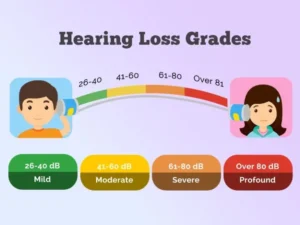Hearing Loss Types, Causes, and Solutions

Any trustworthy audiologist both understands how to treat hearing loss and knows that the biological mechanisms underlying it might confuse the average person. After all, nobody can look inside their own ear to determine what exactly is causing their hearing loss. That said, all prominent hearing loss types and causes have solutions (though not cures), so below, we’ll demystify the most common hearing loss types, causes, and solutions.
Types of hearing loss
The three primary types of hearing loss are:
1. Conductive hearing loss
- What it is:Conductive hearing loss is hearing loss that occurs when the outer or middle ear is damaged or blocked, thus stopping the conduction of sound to the inner ear.
- How it’s caused: Many conditions can result in blockages that cause conductive hearing loss, including excessive ear wax, a narrowed ear canal, ear infections, and fluid buildup.
- How it’s treated:Temporary conductive hearing loss is typically treated medically or surgically. Permanent conductive hearing loss may require hearing aids.
2. Sensorineural hearing loss
-
- What it is: Sensorineural hearing loss occurs in the wake of damage to the ear’s hair cells or auditory nerve. The result is less information about audio volume or clarity for your brain to process.
-
- How it’s caused:Sensorineural hearing loss is commonly just age-related hearing loss, though exposure to loud noise can cause it as well. In fact, just one instance of exposure to extremely loud sounds can be enough to cause sudden sensorineural hearing loss. Less commonly, diseases, genetic syndromes, injuries, infections, and cancerous growths can cause sensorineural hearing loss. Ototoxic medications can also cause sensorineural hearing loss, though ototoxic hearing loss is sometimes reversible.
- How it’s treated: Sensorineural hearing loss is often permanent, so hearing aids are the best paths of treatment. If this hearing loss is tied to a disease or infection, corticosteroids can also help to keep the hearing loss from worsening.
3. Mixed hearing loss
- What it is: As its name suggests, mixed hearing loss contains aspects of both conductive and sensorineural hearing loss.
- How it’s caused: Injury or trauma most often leads to mixed hearing loss, as few other circumstances can lead to the obstruction or damaging of all parts of the ear.
- How it’s treated: Treatment for mixed hearing loss depends on the exact amount of conductive versus sensorineural hearing loss. Surgical or medical treatments may have better outcomes for mixed hearing loss that’s more conductive. For mixed hearing loss that’s more sensorineural, hearing aids may prove more effective.
Degrees of hearing loss
Any type of hearing loss may occur to only a slight or an extreme degree. Audiologists generally acknowledge four such degrees:
- Mild hearing loss describes difficulty hearing some soft sounds even if it’s mostly easy to understand speech.
- Moderate hearing loss describes hearing next to nothing if someone is speaking at a typical, everyday volume level.
- Severe hearing loss describes hearing nothing during a standard-volume conversation and only hearing some loud sounds.
- Profound hearing loss is mostly the same as severe hearing loss, but it describes an inability to hear anything other than extremely loud sounds.
Other hearing loss descriptions
Audiologists often need just a type and degree to classify hearing loss, but sometimes, the below descriptors help too:
- Unilateral or bilateral. Unilateral hearing loss occurs only in one ear, whereas bilateral hearing loss occurs in both.
- Pre-lingual or post-lingual. In children, pre-lingual hearing loss occurs before the child learns to speak. All other hearing loss is post-lingual.
- Symmetrical or asymmetrical. Symmetrical hearing loss is the same in both ears, whereas asymmetrical hearing loss is different in each ear.
- Progressive or sudden. Progressive hearing loss worsens gradually over time, whereas sudden hearing loss occurs quickly and unexpectedly.
- Fluctuating or stable. Fluctuating hearing loss changes in degree over time, whereas stable hearing loss remains of the same degree at all times.
- Congenital or acquired/delayed-onset. Any hearing loss with which someone is born is congenital. All other hearing loss is described as acquired or delayed-onset hearing loss. In general, more people experience acquired hearing loss, so audiologists and hearing aid specialists are especially well-versed in treating this type of hearing loss.
What to do if you think you have hearing loss
If you think you have hearing loss of any sort, contact an audiologist for a hearing test. Audiologists such as those at I Love Hearing bring not just decades of experience to the table, but also specialty testing tools suited for all types of hearing loss and patients.
Here at I Love Hearing, we also specialize in offering and fitting hearing aids to address hearing loss (and tinnitus, which isn’t a cause of hearing loss but is surely unpleasant). We offer virtually every reputable hearing aid brand on the market, and we’ll always let you try your hearing aids out before you spend even a penny on them. We’ll work with you throughout the hearing aid choosing and fitting process to meet your individual needs. To address your hearing loss before it potentially worsens, contact us now to book an appointment in one of our four New York metro offices: East Meadow, New Hyde Park, and Port Washington on Long Island, and on the Upper East Side of New York City.

